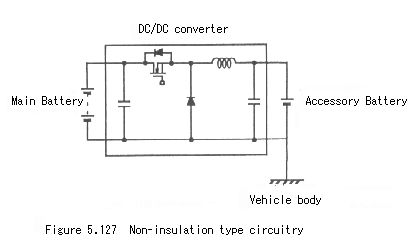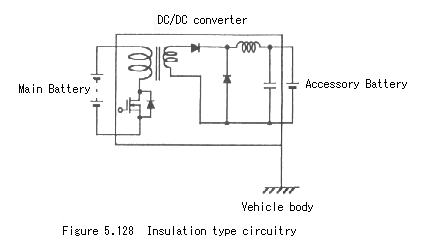1) Outline
A DC/DC converter is equivalent to an alternator for an internal combustion engine,
supplying electrical power to the accessories such as lamps, ECUs and small motors, as well as
charging an auxiliary battery as an electricity conversion device.
The alternator is driven by the engine using a belt drive so that mechanical energy is converted
to electrical energy. Thus, electrical power required for vehicle accessories is supplied.
However, in the case of an electric vehicle, there is no engine as a driving source, and in a
hybrid vehicle with idle stop system, the alternator cannot be utilized while the engine stops.
For this reason, the DC/DC converter is required to supply energy to vehicle accessories from the
main battery of an electric or hybrid vehicle.
2) Voltage conversion method
There are two kinds of circuits for the voltage conversion as follows.
- Non-insulation type (Figure 5-127): In this type, the negative terminals of the batteries are grounded to the vehicle body.
Insulation type (Figure 5-128): The positive and negative terminals of the main battery of an electric or hybrid vehicle, which is the energy source of the DC/DC converter, is usually isolated from vehicle body for safety reasons. On the other hand, the negative terminal for vehicle accessories is usually grounded to the vehicle body; as a result, insulation is required between the input and output of the DC/DC converter.
The circuitry of non-insulation type is simple, but insulation between input and output of the DC/DC converter is impossible. Meanwhile, the insulation type is coupled with a transformer so that the insulation between input and output is maintained. This feature is specific to the isolation type.


Reference
Book title: EV Handbook
Written by: EV Handbook Publisher's Group
Published by: Maruzen Co., Ltd. (URL http://www.maruzen.co.jp)
|
|